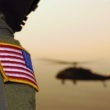Editor’s note: Two years ago, while I was working on a book on Vice President Dick Cheney, a general who had worked closely with the then-Secretary of Defense Cheney during the first Gulf War described the harm Cheney had done to the Army in the second go at Saddam Hussein. Troop strength was reduced to levels not seen since 1941, while troops were redeployed more frequently and for longer terms. “We have never not surged up the Army during times of war,” the general said, referring to the practice of increasing the Army’s size. He also observed that the Army had “burned up Abrams tanks, Humvees, wheeled vehicles, five-tons, eight-tons, Apache helicopters, all very expensive hardware, at a rate which is astronomical.” The Army,” the general said, “is broken.”
This is not an argument the president will hear from General David Petreaus, whose report will support the current troop surge in Iraq. Yet it’s an argument Bush heard when he met with General George W. Casey Jr. and his three fellow Joint Chiefs of Staff in the last week of August. Casey told the president the Army is “stretched out of balance,” according to the New York Times. And that deployments are not sustainable and “equipment usage is five times the normal rate. . . .”
In this issue, Texas-based journalist Robert Bryce examines the metastasizing equipment usage crisis, as the Army orders bigger, slower, and less fuel-efficient armor, in a cycle that appears to have no end. Bryce’s third book Gusher of Lies: The Dangers Delusions of “Energy Independence,”will be published in March.
THERE ARE MANY REASONS WHY the U.S. has lost the war in Iraq: hubris, terrible post-invasion planning, lack of knowledge of Iraqi/Muslim culture, and the failure of the occupation forces to control Iraq’s oil sector. But on the most basic tactical level, America has been defeated in Iraq because it cannot effectively counter the defining weapon of the Iraq War: the roadside bomb, which is also known by its now-familiar acronym, the IED, short for improvised explosive device.
The deadly effect of the IEDs can be easily seen by looking at the numbers, which show a steady increase in the percentage of U.S. casualties caused by the devices. From January through early August of this year, just over 52 percent of all the fatalities among U.S. soldiers in Iraq were due to IED attacks. Over the course of the war, more than 1,460 American soldiers have been killed by IEDs. Thousands more have been wounded by them, many of them seriously.
The U.S. military has already spent about $10 billion on IED countermeasures, including heavier armor for Humvees and trucks and a panoply of electronic jammers and other high-tech gizmos that promised to neutralize the explosives. But all that spending has had little discernible effect.
Despite the lack of progress, the Pentagon has launched yet another anti-IED effort, which will dwarf all prior spending programs. Over the next four years, Congress, the White House, and the Pentagon plan to spend about $20 billion on a fleet of 23,000 heavily armored vehicles that go by the acronym of MRAPs, short for mine-resistant ambush protected vehicles. The first big order for 1,520 MRAPs at a cost of $5.3 billion, or $3.5 million per vehicle, was placed in August.
But like all of the previous anti-IED programs, the MRAP effort will only add more expense to the losing effort in Iraq. While the MRAPs will provide additional protection to American soldiers on the ground, they will not solve the IED problem. Indeed, the deployment of the MRAPs exposes three interconnected points that continue to frustrate U.S. efforts in Iraq:
1. The IEDs have put the U.S. military in Iraq in a defensive posture. And militaries who play defense all the time don’t win wars.
2. The MRAPs will dramatically increase the size of the already gigantic logistics “tail” that sustains the U.S. military in Iraq. The larger the tail, the more vulnerable the military becomes.
3. The new fleet of MRAPs won’t make any difference in the overall casualty rate for U.S. soldiers. That’s the opinion of a Defense Department analyst who has worked on the IED problem for several years and was recently in Iraq.
PLAYING DEFENSE—The push for MRAPs began in February 2005 when Marine Corps commanders requested the vehicles in order to provide better protection for their soldiers in Anbar Province. The Pentagon waited nearly two years before it agreed to scale up production of the vehicles. The delay has been blamed for the unnecessary deaths of dozens, or even hundreds, of American soldiers in Iraq.
There’s no question that the MRAP vehicles, which have V-shaped hulls and thicker armor than Humvees, are better able than Humvees to resist roadside bombs. But the very need for a larger, heavier vehicle shows that U.S. forces in Iraq are on the defensive and that the insurgents are largely dictating the terms of the fight.
By using IEDs, the insurgents are increasing the “friction”—a term coined by the 19th-century Prussian military strategist Carl Von Clausewitz for forcing enemies to do things they don’t want to do—that the U.S. military must overcome. Evidence of that friction abounds.
That friction became obvious in the first few months of the military occupation of Iraq. As IED attacks grew in number, the U.S. military began hurriedly to retrofit its existing fleet of “soft-sided,” or unarmored, Humvees with armored ones. Throughout 2005 and 2006, the Pentagon gave regular updates on the progress of the “up-armoring” program. By late 2005, it claimed that two-thirds of the 22,000 Humvees in Iraq had been fitted with some type of armor. During my June 2006 visit to Camp Arifjan in Kuwait, the first stop on my tour of the base was a large warehouse dedicated to adding yet heavier armor to the Humvees. Army officials showed me the latest edition of the “armor kit” being added to a dozen or so vehicles in the warehouse, a kit that included more steel on the doors and reinforced door hinges.
The ongoing Humvee-armoring process ran parallel to another example of the friction facing the U.S. military: the need for better body armor for the soldiers on the ground. The IEDs were inflicting serious wounds on troops riding in their vehicles. And those injuries led to the development and deployment of more extensive personal armor. Today, in addition to their armored vests, U.S. troops in Iraq are wearing armored epaulets in order to protect their shoulder joints from potential IED blasts.
Another example of friction: in addition to all the heavy metal, the U.S. military has spent billions on electronic jammers ($1.4 billion in 2006 alone), in an effort to prevent the roadside IEDs from detonating. But the jammers, which were mounted on the front of military vehicles, had the unfortunate effect of jamming the vehicles’ radio systems. And that self-jamming required spending additional millions of dollars on electronic systems capable of overcoming the jammers.
The failure of the jammers has led the Pentagon to push the MRAP program. To accelerate production, it has awarded multimillion-dollar contracts to several military contractors, including BAE Systems, Force Protection Industries, International Military and Government, and General Dynamics.
While many soldiers are eager to get the MRAPs, there is plenty of skepticism about the ability of the U.S. military to solve the IED problem. That sentiment was summed up by an Army captain who served in Iraq for fifteen months and was riding in a Humvee that was hit by an IED. (He wasn’t injured by the blast.) I asked the captain, who asked me not to use his name, if the U.S. can solve the IED problem. He quickly replied, “No. . . . Every time we think of a way to counter the IEDs, they come up with something else.”
THE PROS STUDY LOGISTICS—There’s an old saw in the military that goes, “Amateurs study tactics; professionals study logistics.” And when it comes down to the essential elements of the Iraq War, the fight is all about logistics. The U.S. military in Iraq manages to continue its occupation only because of a logistics operation involving tens of thousands of trucks. The fleet of fuel tankers alone includes more than 5,500 vehicles. On an average day, some 2,000 trucks carrying food, water, fuel, spare parts, water tanks, generators, furniture and other equipment leave Kuwait for destinations inside Iraq. The addition of the MRAPs will only add to the logistics burden, particularly for fuel and spare parts.
By mid-2006, the U.S. had some 40,000 motor vehicles in Iraq. The current plan is to replace all of the armored Humvees in the country with MRAPs. The older Humvees will then be turned over to the Iraqi military.
That may be a workable plan, but doing so will only increase the military’s need for motor fuel—all of which must be imported from Kuwait and Turkey. (The U.S. military has never relied to any substantive degree on Iraq’s decrepit refineries for its motor fuel needs.) And those fuel needs are climbing dramatically. Between 2004—when the magnitude of the IED threat was still being recognized—and mid-2007, the amount of motor fuel used per soldier in Iraq more than doubled. According to data obtained from the Defense Department under the Freedom of Information Act, in 2004 each U.S. soldier in Iraq was using 8.2 gallons of fuel per day on average. By the end of July of this year, consumption had jumped to just over 20 gallons of fuel per soldier per day. (The average Iraqi uses less than one-half gallon of fuel per day.)
Thus far, about 500 MRAPs have been delivered to Iraq. But those MRAPs—and the ones that will follow—will mean an even greater demand for fuel. An armored Humvee weighs about 12,000 pounds and gets about 8 miles per gallon. The base model MRAP, known as the RG-31, or Cougar, weighs 38,000 pounds and may get 4 miles per gallon, or less. Other MRAP models, such as the RG-33, weigh 52,000 pounds. The largest MRAP, an ordnance-disposal vehicle known as the Buffalo, weighs 80,000 pounds, or forty tons.
The costs of providing fuel to the new fleet of MRAPs will be enormous. Last November, a study produced by the U.S. Military Academy estimated that delivering one gallon of fuel to U.S. soldiers in Iraq was costing American taxpayers $42. At that rate, each U.S. soldier in Iraq is now burning up $840 per day in fuel delivery costs—and that number doesn’t include the cost of the fuel itself.
The increased demand for fuel will come alongside the need for an entirely new set of spare parts, tires, fan belts, windshields, alternators, and other gear needed to support the MRAPs. This swelling of the logistics train creates yet another problem for the U.S. military: the increased number of supply trucks on the road will provide yet more targets for the insurgents and their IEDs. It’s Catch-22.
BIGGER MRAPs, BIGGER IEDs—While the issues of friction and logistics are important, the key question about the MRAP deployment is this: will the new vehicles make a difference? The answer: don’t count on it.
The MRAP is already “useless,” says a Defense Department source who is an expert on the IED problem. “The people who believe it offers additional protection are fooling themselves. The other side [the insurgents] has already found out how to neutralize it.” The “trend lines are going in the same direction as they have since 2003. Nothing has changed,” said the source, who asked not to be identified because he is not authorized to speak to the press. “The casualties per explosive had been reduced because of armor. But over the past three or four months that’s changed. There’s been a 25 percent increase in the effectiveness of the IEDs.”
The IEDs are getting more effective for two reasons: 1. the insurgents are building more powerful IEDs; and 2. they are using increasing numbers of a “super IED.” It goes by yet another acronym, EFP, for “explosively formed projectile.”
The trend toward ever-more-powerful IEDs has been going on since the beginning of the war, but the insurgents have figured out that they simply need to increase the size of their explosives in order to disable or destroy an MRAP. And increasing the size of their bombs poses little difficulty in a country awash in explosives. The Defense Department has estimated that there are about 7 million tons of large-caliber ammunition in the country.
In August, General William Wallace, the head of the army’s Training and Doctrine Command, admitted that the MRAPs remain vulnerable. “We also understand that all they [insurgents] have to do is add a little bit more explosive weight to the IED and they could probably begin to counter some of our latest protective systems like [MRAPs] in the not-too-distant future.” He went on, saying it would be “foolhardy” not to expect that to happen.
The insurgents are also increasing their use of EFPs, which now account for about 5 percent of all the IED attacks on U.S. forces. EFPs are simple to manufacture and can be built in almost any moderately equipped machine shop. Here’s how they work: The heat and shock wave created by the detonation of explosives inside a shallow metal tube propels a metal plate mounted at the front of the weapon. That plate—usually steel or copper—forms a molten metallic “dart” that travels at speeds of up 2,000 meters per second and can penetrate 4-inch-thick armor at a range of up to 100 meters. That means that not even the M1 Abrams tank—the backbone of America’s armored infantry—can withstand a direct hit by an EFP. It also means that EFPs are more likely to kill or maim soldiers.
And here’s the worst of it. According to the Defense Department source, the number of EFPs encountered by U.S. troops in Iraq has more than doubled over the past ten months or so and now number about 100 per month. Although EFPs account for just 5 percent of the IED attacks, they are responsible for 30 percent of U.S. combat deaths.
G.I. Wilson—a former Marine Corps colonel who has written extensively on insurgencies and asymmetric warfare and served 28 years on active duty, including fifteen months fighting in Iraq—agrees that the deployment of the MRAP will not make much of a difference. Wilson, who now lives in California, said the MRAP is just part of the ongoing effort by the Pentagon to protect troops while neglecting the need to adopt more-creative tactics on the battlefield. “At what point do we get so much armor that we become ineffective?” he asked. “I think we are at that point.”
By the end of the year, the Pentagon hopes to have 3,500 MRAPs in Iraq. To save time, many of the MRAPs are being flown to Iraq aboard military transport planes rather than send them by ship. The cost of flying one MRAP to Iraq: $135,000.






0 Comments